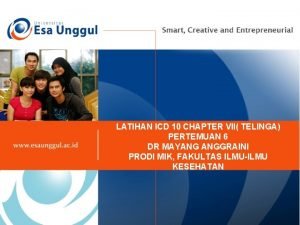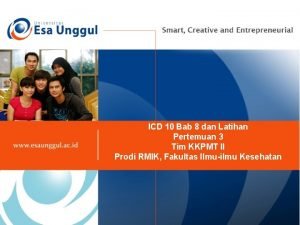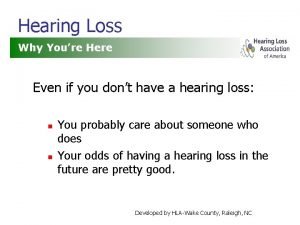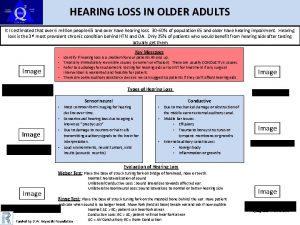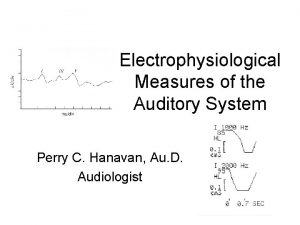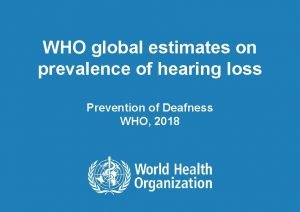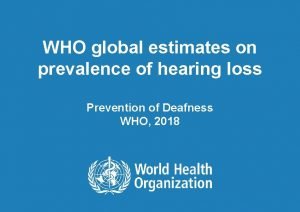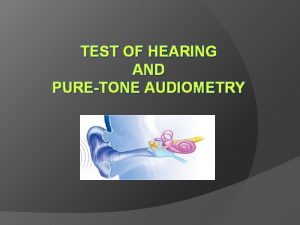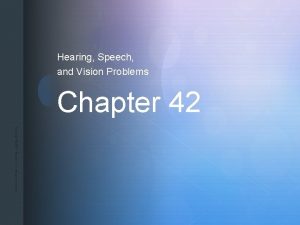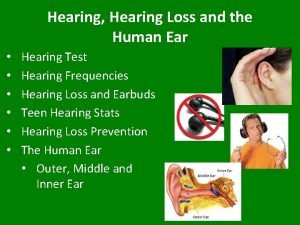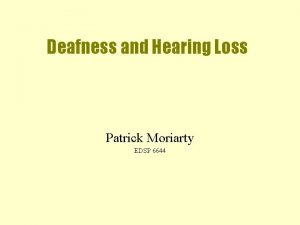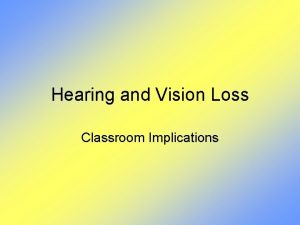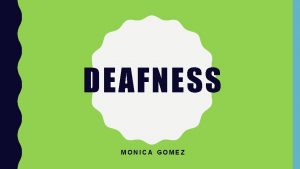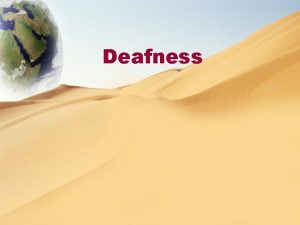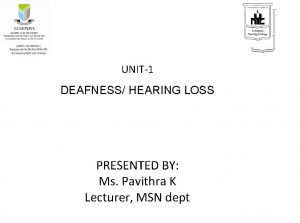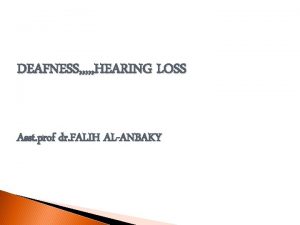Chapter 10 Students with deafness and hearing loss












- Slides: 12

Chapter 10: Students with deafness and hearing loss S

Definitions S Hearing impairment – not “deafness” S In order to receive services, the hearing impairment must adversely affect educational performance S Deafness – child is severely impaired, cannot process linguistic information through hearing….

Deaf culture S Members of deaf community who embrace deaf culture. S Deaf culture 1) deafness 2) using ASL 3) attending a residential school for deaf S Fundamental idea: deafness is not a disability, not something that needs to be fixed S Identity with it’s own rich history, traditions and language S (conferences, dances, etc…)

Types: S Hearing loss present at birth: congenital S Hearing loss that develops after birth: acquired S (Was loss pre-lingual or post lingual – has the child ever heard spoken language? )

Causes S Prematurity, intrauterine infection, maternal diabetes, toxemia, anoxia, malformation of ear (prelingual) S Meningitis, ear infections, encephalitis, head injury, extreme exposure to loud noises

Issues S Deaf parents vs. hearing parents S Communication S Academic issues S Social/Emotional Characteristics S Behavior Characteristics

The IEP S Needs to include (diagnosis, severity of hearing loss, strengths, things child needs work on ). S Also: Preferred communication needs of child/family S Linguistic needs, academic needs S Social, emotional, and cultural needs (opportunities for peer interaction/communication)

Whatever the educational situation, it is important that: S Student is developing age appropriate communication skills S Student is making satisfactory progress S Student has friends S Student has access to all components of the educational process (lunch, recess, social activities)

Transition/adulthood Transition/planning skills so important! These are smart kids, but they are sometimes underemployed, underestimated, and have untapped potential! (job shadowing, apprenticeships, career fairs, providing great role models are so important!)

Important! S Deaf/hard of hearing teachers so important! When thinking about the perspectives of parents/families, know that you cannot know exactly what they are going through unless you are in the parents’ “shoes”.

Trends and Issues S Universal newborn hearing screening – most infants hearing screened for congenital hearing loss before they leave hospital S Cochlear implants (allows those with profound hearing loss to perceive sound) Deaf culture debate… S Residential/charter schools with bilingual/bicultural approach (ASL as primary language – English taught as second language through reading – print)

Websites: S http: //nichcy. org/disability/specific/hearingloss S http: //www. asha. org/public/hearing/disorders/children. htm S RIT. edu and the National Technical Institute for the Deaf S Gallaudet University
 Tuli icd 10
Tuli icd 10 Icd x gangguan pendengaran
Icd x gangguan pendengaran Cookie bite hearing loss
Cookie bite hearing loss Conductive hearing loss lateralization
Conductive hearing loss lateralization Tympanometry types
Tympanometry types Absolute bone conduction test
Absolute bone conduction test Who global estimates on prevalence of hearing loss 2020
Who global estimates on prevalence of hearing loss 2020 Who global estimates on prevalence of hearing loss 2020
Who global estimates on prevalence of hearing loss 2020 How to perform rinne test
How to perform rinne test Difference between normal loss and abnormal loss
Difference between normal loss and abnormal loss Chapter 42 hearing speech and vision problems
Chapter 42 hearing speech and vision problems Why did rizal salute to luna and hidalgo
Why did rizal salute to luna and hidalgo The receptors for hearing are the
The receptors for hearing are the
